Content
Nowadays, it is hard to imagine training without an Learning Management System (LMS). It doesn’t matter whether you study in a state university or a corporate university, an LMS is critical to effectively training your team.
In this article, you will learn what an LMS is, how to make learning management system development from scratch, what LMS features modern companies use, and several other critical LMS points.
Nowadays, almost every industry-specific business embraces advanced technologies. Due to the global pandemic COVID-19, leveraging technology-powered solutions is increasing, and the education industry is not an exception. That’s why online learning has skyrocketed – according to the MarketsandMarkets report, the global eLearning market value is anticipated to reach almost $22.4 billion.
Modern learning management system platforms are distinguished by a convenient and flexible interface, comprehensive functionality, and distance learning on a new level. LMS training systems allow you to organize the learning process from scratch and monitor learners’ success through the creation of online courses or virtual classes, available anytime and anywhere in the world where there is an Internet connection. All training materials are stored in one place, making it easy to adapt and revise depending on the needs of the company or organization.
If you are looking for solutions to build your learning management system, we have prepared a brief guide with its features and advantages. Let’s go into details to understand what an LMS system is and what functions it covers.
We’ll reply within 8 working hours (CET)
History of LMS projects
The idea of distance learning was first embodied in the 18th century, when one American scientist organized correspondence courses on stenography, publishing material in the newspaper.
After another one hundred years, this system improved when the possibility of user feedback appeared. The teacher would send the lesson and homework by mail, and after the student studied it, they would send the completed homework back.
The next step in the development of learning management systems was the audio and video possibilities with courses on video and audio cassettes. But the most powerful and decisive breakthrough made progress in the field of information technology – the computer.
After the invention of the computer, local networks from several combined machines began to appear.
This became the latest and most decisive step in the development of the distance learning system: the Internet.
This global network facilitated people’s access to information. In response to this, learning management system platforms were invented.
They allowed people to train remotely and independently of each other, as well as train a lot of students at the same time.
A learning management system is software designed to optimize learning processes and the way the education is delivered. Initially, LMS’s purpose was to enhance eLearning.
Now, enterprises use learning management system programs to ensure effective and efficient team-building by improving employee training, tracking, and reporting features to make eLearning systems more solid, offering effective assessments.
Two main types of LMS vendor:
- Hosted LMS
Such a system is deployed into the owner’s host, and he can access learning to those who are associated with this host. This is the first type of LMS, which has emerged in universities and is still used. Owners of large corporations choose this type to control the system and keep information secure.
- Cloud/SaaS LMS
The content is deployed into the LMS program’s host. The owner and users receive access via the Internet. This is the most common type of platform for distance learning.
Because of its simplicity and ease of use, it is chosen both by owners of private online schools and company executives to improve corporate learning.
Who Needs an LMS Platform?
Before asking how to build an LMS, think about the people who will use it. Training management systems are needed to centralize training activities and control them. Modern learning management system is a system that supports many corporate use options, including:
- Customer training. This kind of training is for companies that need to attract users effectively. Customer learning management provides better product value and prevents user outflows.
- Partner training is an excellent way to improve affiliate programs and ensure greater value for counterparties by managing partner training.
- Supplier training is an exceptional opportunity to establish productive relationships and achieve mutual understanding using an LMS as a service for supplier learning.
- Employee training is used to increase the value of learning by creating centralized training content and facilitating interaction between employees using digital learning. Onboard learning management systems are extremely popular nowadays.
- The development and retention of employees. The use of an learning management system to manage personnel development is to support talent, as well as train and develop personnel and their skills. Within the framework of an LMS, courses can be assigned to ensure that the staff acquires the necessary skills of work, has been informed about changes in products, etc.
- Employee testing and certification. An LMS is often used to receive compulsory training and check knowledge, tolerances, regulatory documents and certifications.
- Sales training. LMS plays a central role in the sales training system and provides sellers the necessary knowledge when they need it.
- Remote work. In current conditions, the distance learning system of remote employees becomes a vital necessity.
- HR solutions. This is a unique ability to digitize databases and documents, create programs for personnel and automate up to 70% of the personnel department’s routine work.
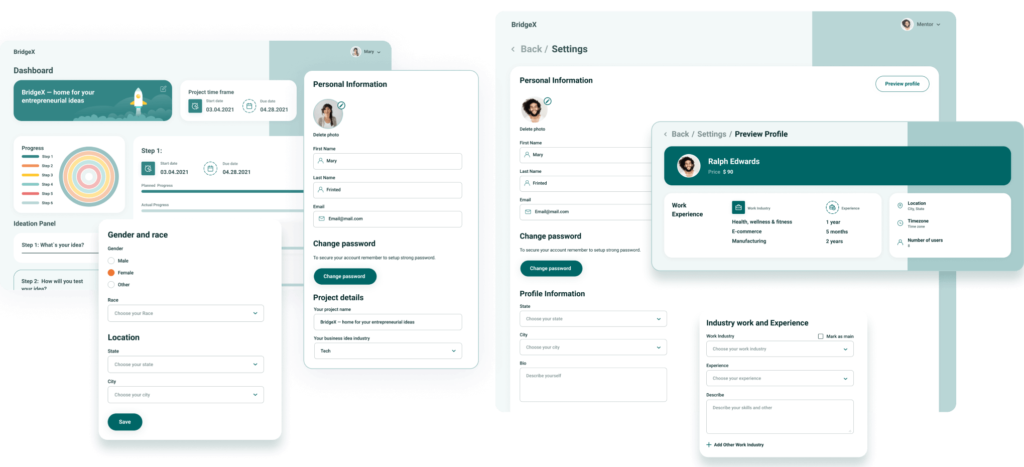

How to Come Up With Your LMS idea
Before you create LMS from scratch, you must thoroughly think over the LMS idea.
99% of new projects die. Why do these projects die? Because the product is not needed on the market and no one wants to use it.
The work on the project should begin not from wording a particular product description but from generating a common idea, the overall task you want to solve.
The idea is about why you want to create something, what you want to change by offering your product and how your product can change your audience’s life.
When you think over these things, you can move to the next steps: finding out how your potential customer thinks.
Why do you need to explore your customer?
- To identify the level of demand for your product
- For targeted advertising, therefore, to reduce marketing costs, time-saving and enhance conversion
- To select the best ways of communication with the audience
- To determine the most effective tools and sales channels
Defining a business model is also an important aspect when forming the idea of your future learning management system.
The business model is what distinguishes you from others, and this is your uniqueness. It reflects the basis of your competitive advantage.
Special checklist from our CEO to test your LMS idea
1. Carry out a physical survey according to principle 10 pains and 10 gains. Ask your potential customers what they like the most in LMS platforms, and what annoys them. In fact, to make a successful product, you need to keep these numbers in your head.
2. Read negative reviews on your competitors. This point is similar to the previous one, but with a bigger level of honesty. An angry person is a frank person.
3. Hold a decomposition of your business plan. First, push your and your team’s needs into the background. Determine which average check and number of customers you need to support the workflow and motivation. After that, you will better plan the budget and product development plan.
4. Try to seek expert advice from more seasoned colleagues or a team who has experience in this business field. They will be able to give advice relying on their experience.
Vasyl Polych, Founder & CEO at RewiSoft
How to Start Creating Your LMS
Let’s learn how to build a learning management system. Before outsourcing a web development team of professionals or in-house experts to assist and support you through every step of software development, you need to analyze the process.
Step 1. Validate your idea
Many businesses fail due to their unreasonable investments into the wrong products. In order to prevent loss and anticipate your ROI, it is highly important to gain deep insights into your target audience and conduct industry research.
So before getting started creating an learning management system, validate your idea by learning about its value on the market.
For this purpose, we recommend answering the following questions:
- What problems will my learning management system solve for users?
- Why do I need to develop a learning management system?
- Who are my competitors and how do they manage to provide great UX?
- Who will be engaged in learning management system development?
- What is the budget for learning management system development?


Step 2. Conduct product discovery
To ensure successful product design and development, teams should begin with a comprehensive discovery phase. Through this iterative process, collaborative efforts are focused on uncovering users’ true needs to craft an effective solution that delivers real user value.
Additionally, the team will research markets and competitors and identify appropriate business goals and monetization strategies for your project – helping you gain accurate timings of when it is set to be completed.
Step 3. Create an LMS project plan
Thoughtful planning of the future product functionality and the analysis of the learning management system requirements play a vital role in the entire project.
The entire plan should be clearly described, and the process should be based on the established techniques, the product should be carefully documented, all tasks are planned and monitored.
The learning management system development plan should describe the entire development process and associated tasks based on past projects’ accumulated experience and success. This will help facilitate many tasks and avoid situations leading to the failure of the product.
Step 4. Select the best LMS design & web development partner
Before selecting a service provider for your learning management system, there are several tips worth taking into consideration:
Communication
Visibility and transparency in communication with the app development team you are going to hire need to be of high priority in order to prevent the risk of getting a different product than you envisioned. Your app development partners need to understand your requirements and elaborate upon them if needed.
At RewiSoft, we keep our clients up-to-date at every step of product design and development providing all the details on the tech stack we use. It is essential to only start work on the product once all the features of the learning management system are discussed.
Experience
The company that had prior experience and expertise in the domain is already aware of the possible pitfalls and how to mitigate risks. If the development team is experienced, they have ready-to-use features that can be utilized in your learning management system development so that development time will be reduced as well as your budget.
Pricing
The company worth hiring for the development of your learning management system system has to be flexible enough in terms of the pricing model that would be the most suitable for you. At RewiSoft, we tend to offer pricing models such as:
- A fixed price (when our development team perform a certain scope of work for determining price)
- Time and material (the client pays for the time spent on product development)
- Dedicated team (monthly payment for our team rented by the client)
Expertise in E-Learning and 24+ other sectors at your service
Post-launch support
Signing a contract with the app development team is a good idea if you want to get continuous technical support during the year, for example, or just want to fix particular problems as per written request.
Step 5. Start from MVP of your LMS idea
To develop an learning management system platform right, we recommend starting with the MVP of your LMS idea. A minimum viable product is a method to test your product by developing only core features to solve early adopters’ problems and mitigate risks in the long run. In our article about MVP for startups, you can get clarity on the benefits and process of the minimum viable product before custom learning management system development.
An MVP checks the working hypotheses and gathers consumer responses. Often the company spends years working to test their hypotheses. A study by CB Insights showed that in 42% of cases, the cause of the startup’s failure came from lack of market demand. An MVP helps make sure the product is in demand so your startup will be successful.
The best part of an MVP is that you create a real product that can be offered to customers. After observing the response to it, you can move forward with developing the product, taking note of consumers’ preferences. This way, the company will not start creating a product that customers will not want to buy, reducing the time and effort it takes to develop a successful product.
Step 6. Create your own LMS design with the right UI/UX design
The learning management system’s design should be simple and colorful, motivate learners to study, keep them focused, and not distract them from anything (advertising, other courses, pop-up windows, etc.). For design development, it is best to hire a specialized agency. At RewiSoft, we have great experience in providing UX/UI design for LMS solutions.
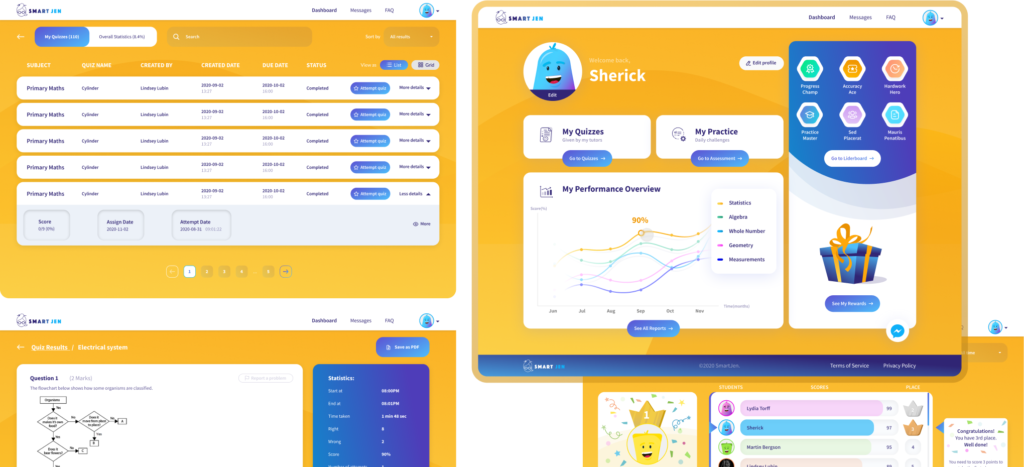

According to SmallBizGenius, 88% of online users say they wouldn’t return to a product after having a bad user experience. People form 75% of their judgment based on a product’s credibility purely on its aesthetics.
Since technology is becoming increasingly integrated into our daily lives, it is not surprising that users expect their online training platform to be fully responsive to work on various computers, laptops, tablets, and smartphones.
A bad UX can easily discourage a learner from being in the right mindset to learn, leaving them feeling disengaged and frustrated, no matter how great the content is.
During the design phase, essential elements such as sketching ideas and developing concepts come together to create a unique experience. This often includes crafting visuals, selecting colors and fonts, and planning user flow across pages or screens – ultimately producing an innovative product that will fulfill customer needs. Here are the main steps of UI/UX design process:
- Sketching. Through sketching, we can quickly bring our ideas to life! It’s an ideal brainstorming technique – allowing the whole team to explore a variety of design options before making any decisions. From paper and whiteboards all the way through digital tools – let’s get those imaginations flowing!
- Wireframing. With wireframing, designers are empowered to conceive the page structure early on. It becomes a crucial backbone that supports product development investments and empowers them with direction while they develop mock-ups or prototypes.
- Prototyping. Wireframes provide an outline of the product’s structure and present visual hierarchy, while prototypes give insight into how users will interact with this formation. Prototypes can range from simple clickable wireframes to complex coded simulations to best imitate the final outcome.
- Design system creation. To ensure the successful implementation of large-scale projects, designers create a unique system that involves components, patterns & styles. This ensures alignment between the design team and developers throughout all stages of development.
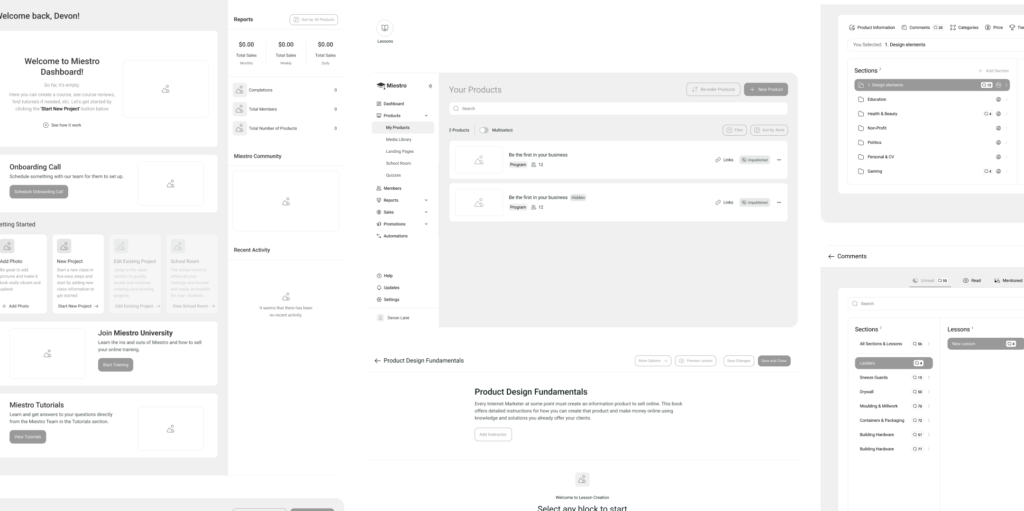

Step 7. Begin user testing
User Testing is a type of research in which the test audience will use your product. So you can see what works and what doesn’t. Testing learning management system development is necessary, as they contain many functionalities and a large number of people will use them in the future.
User testing should be carried out at an early stage of learning management system development. Advantages of user testing:
- It helps determine the average time spent by user groups to perform essential tasks
- It saves a lot of money and time in the long run because the restructuring of the LMS is not an easy task
- It provides the best user interface for users of all demographics
- Companies can receive helpful information about how satisfied users are with their LMS
At RewiSoft, we use UX Eye Tracker, which explores user behavior during interaction with the product. Only 1% of companies use this method.
It helps designers and development teams optimize the interface and product design. Thanks to our UX LAB and UX Eye Tracker, we have significantly improved the SmartJen platform design and added more advanced features.
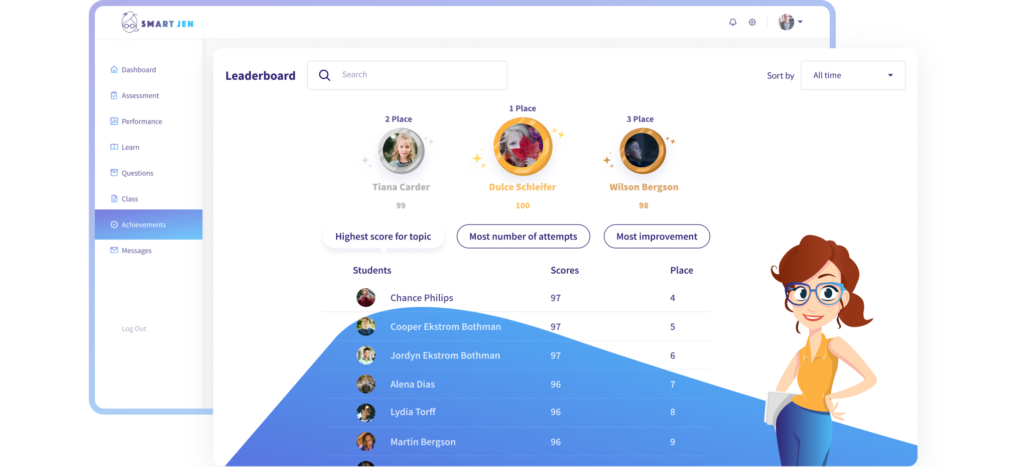

SmartJen is one example of an online learning management system that helps teachers save time preparing for their classes while making the learning process more organized and fun.
Step 8. Start your LMS development
To build LMS from scratch successfully, you must not miss anything. After you have completed all previous steps, you can start custom learning management system development. At this stage, you will make the transformation of your idea into a material product, considering all the critical points of learning management systems that we mentioned above. Your goal is to make sure that the concept of the product can be brought to the working sample.
Learning management system development process is usually divided in several steps:
- Tech stack & documentation. LMS development team determines technologies that will be appropriate for the project. The team compiles technical documentation describing all the features and functionality and the relationship between user roles.
- Architecture plan. Developers create the basic structure of the product. On the back end, they choose whether it will be, for example, a monolith or microservices and choose the controllers and types of APIs they will use. On the front end, developers determine how the user interface will be implemented and schematically depict which parts of the product will interact with each other.
- Sprints planning. At this stage, the team determines the priority and sequence of features creation. This stage is critical because the entire product LMS development plan is based on it.
- Infrastructure setup for testing + CI/CD to the test servers. DevOps set up the production-like environment for running the developed application on the cloud. The customer has access to it and can also test the product. The team configures the system so that all changes the team makes to the product automatically appear in this environment.
- Client and server development & QA. At this stage, client and server parts of the product are developed (development of UI components, API, etc.) and tested.
- Regression Testing. QA tests the entire product thoroughly. We fix bugs that may have appeared when we were adding new features and product components.
- Production Infrastructure setup + CI/CD to the prod servers. The LMS development team creates a separate, more flexible and scalable environment on the cloud that is production-ready. They configure domains and the system so that all changes developers make to the product automatically appear in this environment.
At RewiSoft, we usually assign 2+ developers to run all these processes. Our own learning management system development team consists of middle and senior-level developers.Another important step is the choice of a cooperation model. The most popular models are:
- Time & Material. The T&M contract assumes payment upon completion of work. Collaborating according to the Time and Material model, the company is interested in providing you with a high-quality result in the optimal time – this, in turn, guarantees further successful cooperation.
- Fixed Price. The Fixed Price model assumes that the budget for the development of the entire project is approved before the start of work and remains unchanged. Also, before the start of work, the exact deadline for the completion of the project is approved.
Also important is the choice of the technical stack for your custom learning management system. In order to choose the right stack for your project, we recommend that you consult with experts. For example, the RewiSoft team provides advice on the development of new products, including the selection of technical stacks for projects.
Step 9. Test and launch your LMS solution
Ensuring smooth work of custom LMS features and functionalities by running them through various tests is a must-do. QA professionals guarantee the ultimate product quality and integrity. Here are the main requirements for QA:
- Maintains a comprehensive QA checklist ensuring all designs, content, and assessment resources work properly
- Checks platform and device compatibility of the learning management system
- Scrutinizes every individual functionality
- Performs regression testing after each sprint
Step 10. Gather and analyze results
Before starting LMS development, you should make an analysis of the collected results. The best way is to analyze what you need to improve in the future product, remove everything that doesn’t make sense, consider the strategy you will move on, and prepare for the development of a full-size learning management system platform.
Don’t forget about the custom LMS implementation project plan. All these steps will help you build a valuable and in-demand product.
Step 11. Start building a full-size LMS product
Building an LMS is quite a challenging process. When you successfully go through all the steps we named above, you will be ready to build the full-size LMS platform. Do not rush and miss essential steps. Take into account everything that you did at each previous stage. Since you will have an MVP version of the product, it will be much easier to create a full-size one.
RewiSoft Experience In Creating an LMS From Scratch
RewiSoft team provides robust education software development services for educational institutions, startups, and enterprises willing to digitize learning and provide accessible, interactive, and efficient personalized learning experiences.
We provide custom learning management system (LMS) consulting and development services to help run training, learning, and development programs in both education and business settings. Our skilled software specialists implement different advanced learning management system features to help educational institutions and other businesses meet multiple needs.
Why should you choose RewiSoft for custom LMS creation?
- Versatility. Our development team builds e-learning software to meet different technical requirements and business needs.
- High-performing solutions. With every e-learning software development project we manage, scalability and high performance always come first.
- Compliance with EdTech standards. We closely monitor changes in laws and regulations and currently adhere to GDPR, SCORM, WCAG, xAPI, AICC, DOE, LTI, and other standards.
- Experience and expertise. We have a pool of 50+ talented tech engineers, UI/UX designers, business analysts, project managers, and QA engineers to support you throughout the entire e-learning software development lifecycle, from the ground up to post-release support.
- Rich functionality. We develop a wide range of features that help increase retention, grow your user base, increase student productivity and engage them more in online education.
One of our customers, SmartJen, asked us to improve their existing platform by suggesting new and advanced features to make the user experience more seamless. Furthermore, SmartJen’s existing website was required to be updated and redesigned according to new design trends and best practices.
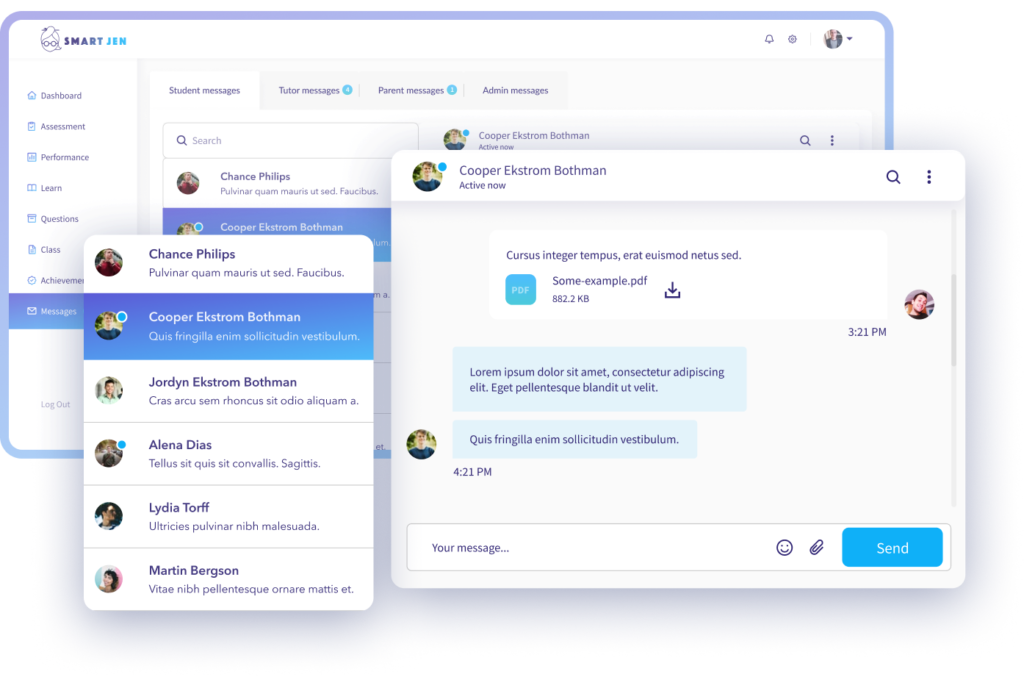

We divided the entire work on the project into the following main tasks:
- Information architecture creation. In order to streamline the content and functionality of the platform, we have created a new information architecture. As a result, user experience, product logic and navigation have improved.
- Platform redesign. Based on the concept of the platform and branding elements, we created a new design system and completely updated the visual part of the platform. As a result, the LMS platform has become more attractive to users.
- User flows restructuring. For a faster, more logical and smooth platform operation, we have restructured user flows to make them more understandable. As a result, it has become easier for users to achieve their main goals.
To inspire learning among students and simplify tutors’ efforts to optimize learning process, we aimed to create user-friendly and smart UX solutions with human-centered essence. So we created a responsive web app paying special attention to convenience while creating and managing assignments for students.
Top Ways to Create an LMS From Scratch
To build a valuable LMS platform, you should first select the way you will build it. We can divide learning management systems into two different types: a ready-made LMS and a custom learning management systems from scratch.
Who needs a ready-made LMS?
A ready-made LMS already exists as a product. It has a basic set of features and is designed to fit many different companies and organizations. These kinds of platforms have the following advantages:
- Quick to start working with
- Cheaper in the short term
- Tested many times by actual users
- Have a community of adopters for mutual support
Who needs a custom LMS from scratch?
A custom LMS or learning management systems from scratch is created with a specific customer’s requirements in mind. Many benefits will push you to choose this kind of system:
- Control. As a product owner, you can decide what your platform will include, from the feature set to the deployment model to content.
- Great security. You can configure your system security and protect your users’ data. You choose the content protection methods before elearning platform implementation.
- Better long-term value. In the long run, a custom learning management system is cheaper than a ready-made one. You do not need to pay licensing fees, regardless of how many users you have.
Comparison of two types of LMS
Before deciding which LMS platform you want to implement for your business, you need to look through the following factors:
- Necessary features in your own learning management system
- The number of students/employees
- The necessity of extra add-ons
- The way of students’/employees’ progress measurement
- Service provider
Core Features of Learning Management Systems
Once you embark on LMS platform development, your development team has to consider the features that can be crucial to your learning management system. Let’s take a look at some basic but essential features for LMS management:
Content and course management
This must-have feature allows the creation of various types of eLearning courses: quizzes, assignments, etc., that will be used for employees’/learners’ training. Therefore, content management is a high-priority feature in an LMS.
Your own LMS should allow users to add various materials to their courses: pictures, videos, charts, audio files, pdf files, etc. Such things significantly increase learners’ engagement and make educational content in courses more attractive.
Skill tracking
This feature is required more for organizations or enterprises where measuring employees’ performances is much more complicated due to undetermined timing for lectures. Thus, the visual skill tracking feature is aimed to assess employees’ skills, allowing them to learn at their own pace with asynchronous learning.
Well-organized statistics help you track the progress of learners, and as a result, you will understand what to keep in your training materials and what to remove.
Also, with the help of a good tracking system, you will be able to check which courses are popular among users and what slides they look at. You will also be able to monitor the level of preparation in each department and division.
Test statistics will help you assess which answer options your learners choose for each task, which questions of the test cause difficulties and what results they receive.
Social learning
Social learning is an effective way to incentivize learners and to help educators reduce the pressure on them.
With a community experience, learners can get quick answers to their questions via chat or forums. By implementing a community feature in your own LMS, you accelerate the overall learning process, giving the learner more motivation in a real-time collaboration mode.
Gamification
Over the past couple of years, gamification has become one of the main trends of modern corporate eLearning. According to the TalentLMS Gamification Survey study, the staff feels more motivated, productive and happy if gamification is used in eLearning. 61% of respondents are already trained using gamification and remain very pleased.
Another 33% would like to see more gamification items in their educational software.
Incorporating game design elements engages and inspires learners rather than traditional classrooms that lag behind in the modern lifestyle. Game-like incentives such as leaderboards, rewards, and levels can build stronger teams in your company or motivate students to keep learning.
Gartner analysts claim that the gamification feature is not necessary due to the high expenditures of its implementation in an LMS, and there are already several ready-made solutions.
However, those that really address your needs are hard to find. Therefore, hiring a software development team or LMS gamification provider may be a reasonable decision if you want this feature to be customized.
Test and survey management
Today, many companies and training centers focus on online testing, feeling all the benefits that carry this tool for testing knowledge and skills. Test and survey management is an essential part of an elearning platform.
Online testing is used in various forms – these may be questionnaires, linguistic and numeric tests, or abstract logical tasks. Sometimes you need to give oral answers to the program questions.
The techniques are always different and depend on the organization’s goals. Testing in training centers is a tool that makes it possible to objectively assess the knowledge and skills of a large number of students, with minimal time and financial resources. Currently, professional testing is used as the first selection stage not only in many large companies but also in small firms.
Applicants must pass automated tests to determine the manner of behavior, motivation, abilities, and candidates’ knowledge. This form of verification can also be applied in corporate training of personnel as a method for controlling performance.
Inserting videos from YouTube channels
YouTube became the most popular video hosting site and the second most visited site globally by the number of visitors. It contains a plethora of valuable educational videos. Adding the ability to insert a YouTube video into your training educational content will help you increase learners’ engagement and efficiency.
Sometimes it is better to show videos with important training material rather than writing long reads. Everybody knows that visual materials are more attractive and easier to understand. You will also save time creating learning content by using this handy feature.
Marketplace model
The essence of this feature is that all materials of the LMS system are published in the form of a marketplace. The users can choose any course they need and purchase it or start studying using their subscription (it all depends on what type of monetization is used in the LMS system).
Many companies use this feature to make their LMS system as suitable as possible for different audiences. After all, you can add materials on absolutely different topics to the marketplace.
Artificial intelligence (AI)
A Learning Management System (LMS) powered by Artificial Intelligence is revolutionizing online training and learning. With the power of AI, these learning management systems automate content management tasks and track learners’ progress while providing an enhanced user experience with contextualized interfaces and real-time updates.
Additionally, they promote cost efficiency all around by automating mundane processes to create a collaborative platform for learners everywhere! The sky’s the limit when it comes to how this technology can continue innovating in the years ahead.
eLearning Requirements and Standards
Here, we will talk about SCORM. SCORM, a format of electronic training courses, is a system of technical rules of the international standard. ADL developed this format in 1999. Almost all eLearning platforms recognize courses published in this format. With SCORM, you can use different programs, educational materials, films, audio lectures, and webinars.
The standard ensures the compatibility of individual software components and allows the reuse of specific blocks of educational materials created by various tools. The standard describes the interaction of learning management systems with a given structure of electronic courses.
With the advent of this format, the eLearning system became more streamlined since to create courses was carried out according to uniform standards. Study materials are packed into zip archives in a certain order.
In archived form, text, image, and video files are used. The procedure for opening a file has become as convenient and straightforward as possible for learning. Today, the format is popular all over the world.
Benefits of the SCORM format
Compared to other standards adopted in distance learning, SCORM provides special benefits to users:
- Completion status. At the end of the course, the system displays the course completion status and the number of points earned.
- Saving progress. If the learner takes a break, the progress is saved. Classes can be carried out in stages, with breaks in training for any number of minutes. If technical failures occur and the course is closed, then all information is saved.
- Structure. Studying the educational material makes it possible to build a course with the rules for moving from one section to another. The learner can first go through the theoretical material, consolidate the knowledge gained with a video lesson, and then take practical classes.
- Modularity. Educational materials in this format are presented in the form of separate modules. Separate blocks can be used in distance learning systems in other courses.
The main advantage is the ease of use, speed of learning, and satisfaction with the needs of the majority. The disadvantages depend on:
- technical means
- lack of practical training
- lack of an individual approach to students
Whether or not to use SCORM usually comes down to a balance of two things: the benefits of using it and the cost (time and money spent implementing it.)
How Much Does It Cost to Create an LMS From Scratch?
At RewiSoft, the starting price for an LMS with a basic feature set is:
- $40,000 for a website
- $40,000 for an app
The final price for learning management system depends on how many functions your project has, how complex your project is, how many elearning platform modules you would like to have, etc.
If you need a chat function, then what opportunities it will provide (chat one on one, group chat, the ability to create separate chats for each class and each item, the ability to connect the board demonstration) affects this as well. If you need the ability to create separate courses, it is vital to understand the functionality that should be assembled on the platform.
To make it easier for you to calculate the approximate cost of your own LMS project, we have prepared a table for you where you can find the cost of each LMS development process depending on the location where the development team is located:
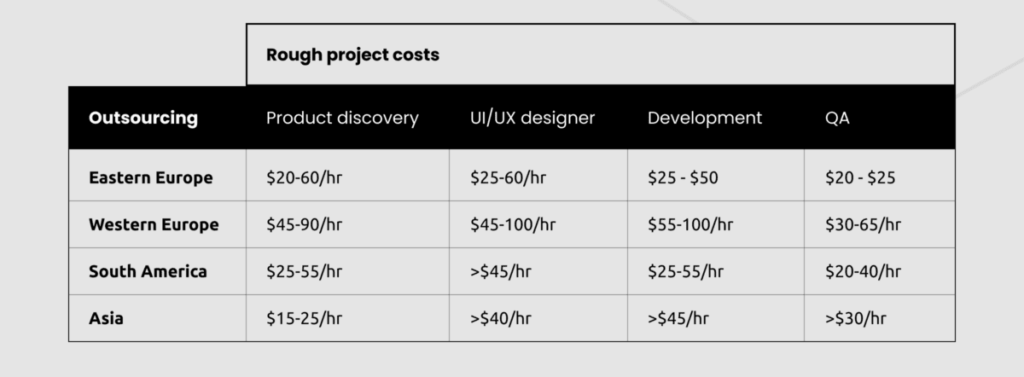

How Long Does It Take to Create an LMS From Scratch?
The time it takes you to create an LMS from scratch depends on the following factors:
- Complexity of the LMS platform
- Number of features
- Design complexity
- Team experience
- Selected tech stack
So that you can roughly calculate the time you need to develop an LMS from scratch, we have created the following table for you:
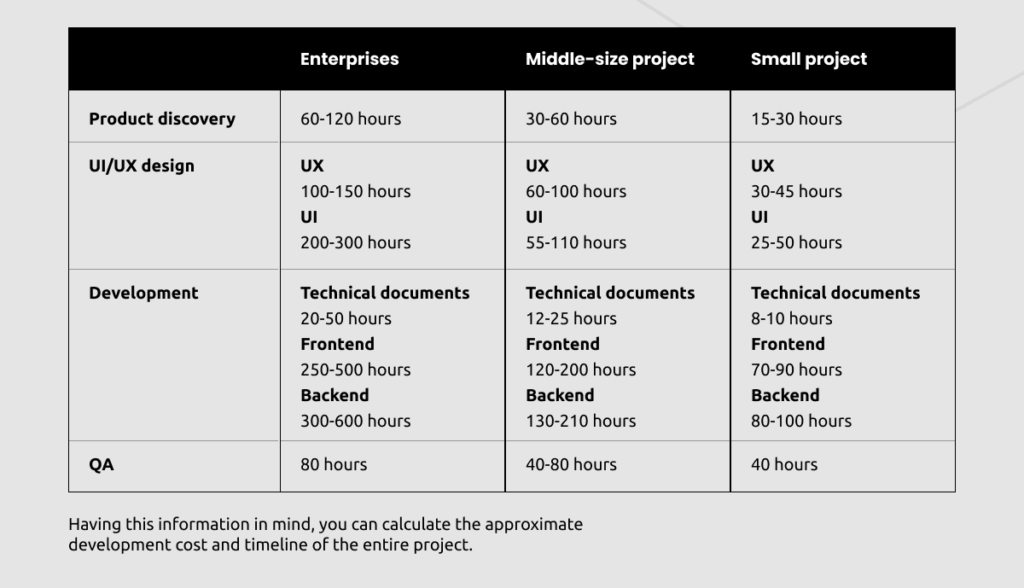

How to Create an LMS From Scratch: Wrapping Up
With technological advancements, the education sector is also changing. To keep up with the latest trends, startups/companies need and carve out their slice in the global LMS market. To do this, startups/companies need to know the best LMS practices and development process.
Developing eLearning mobile app needs a qualified development partner who not only will help you in the development process but also in maintenance and support. If you need help and an estimate of the cost for a custom LMS development, contact us, and we are outsourcing company that always here for you.
We offer end-to-end development services and industry expertise








